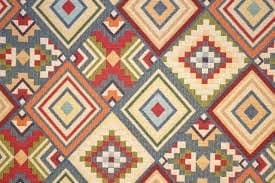The history of Indian textiles is very ancient. The discovery of spindles and a piece of cotton fabric stuck to a vase revealed that the spinning and weaving of cotton was known to harappans nearly 5000 years ago. References to weaving and spinning are also found in the Vedic literature.
The foundation of Indian textile trade began as early as 2nd century BC. Large export of Muslin fabric was done to Egypt and Europe. Before the introduction of mechanized means of spinning in early 19th century, Indian cotton and silks were hand spun and hand woven known as “KHADI”. This played very important role in independence movement. Fabrics that produced by using mill spun yarn but are woven on hand loom are known as “HANDLOOM FABRICS”. Both KHADI and HANDLOOM fabrics are having great demand in today’s fashion industry in India as well as abroad.
In India, a large range of cotton, silk and woolen woven textiles are produce on handloom. Each part of India is known for particular type of textile. Two main types of woven textiles are Brocades and Ikat. Though same type of textile is woven in many parts of India, the designs, colour combination and weaving technique used for it are different. Each has got its specialty. For example brocades produce in Utter Pradesh and in Tamilnadu or Ikats produce in Andhra Pradesh, Gujrat and odisha, are different from each other.
BROCADES
BANARAS BROCADE– These are woven with silk and metallic yarn. For high quality brocades real gold or silver threads are used. Metallic threads are inserted as extra weft. It is wound on small shuttles and used along with the regular weft yarn for crating the design. Both the ends of this extra weft are interlocked with regular weft yarn. Common designs used for these brocades are floral, mango, animals. Colours used are bright.
KANJIVARAM BROCADE– These are also woven with silk and metallic yarn. For high quality brocades real gold or silver threads are used. Metallic threads are inserted as extra weft. Dobby attachment can be used for it. Common designs used for these brocades are floral, mango, animals. Colours used are bright.
PAITHANI– These sarisare manufactured in Paithan, Silk or cotton yarns are used for weaving,40 Km. away from Aurangabad in Maharashtra. These are woven with silk and gold yarns. The specialty of these is palloo (outer end of sari)is woven with real gold warp and weft and design work is done with silk extra weft. This extra weft is wound on small shuttle known as “TILLI”. The border of the sari is woven by using extra warp yarns of gold. For which “DOBBY” attachment is used. Designs are peacock, parrot, lotus, mango or geometrical design known as “Aakruti”. Border of this sari has either geometrical design which is known as “Narali” design or “Aakruti” design. Colours are bright. Generly, border and palloo are in contrasting colour with body of the paithani.
IKAT WEAVING
PATOLA- DOUBLE IKAT technique is used for weaving PATOLA. This is practice in Patan (Gujrat). Silk yarns are used for weaving. Warp and weft threads are tied and dyed according to the design and then weaving is done. Vegetable dyes were used to dye the yarns. Patola sari is used for religious ceremony so the designs and colours used are also auspicious like Kalash, Dancing doll, Parrot, peacock in red, green, blue colors.
POCHAMPALLY- SINGLE IKAT technique is used for weaving pochampally ikats. Silk or cotton yarns are used for weaving.These are woven in Pochampally villege in Andhra Pradesh. Only one set of the yarns are tied and dyed. Designs and colours are similar to Patola.
BANDHANA – DOUBLE IKAT or SINGLE IKAT technique is used for weaving fabrics. This is practice in sambalpur,and Baraghar district of Odisha. Silk or mercerized cotton yarns are used for weaving. Designs are also different than patola and pochampally. Shells and geometrical designs are used. Bright colours are used.
Mrs. Milan V. Desai.
Associate Professor,
Textiles and Apparel Designing
Sir Vithaldas Thackersey College of Home Science (autonomous),
S.N.D. T women’s University, Mumbai.





